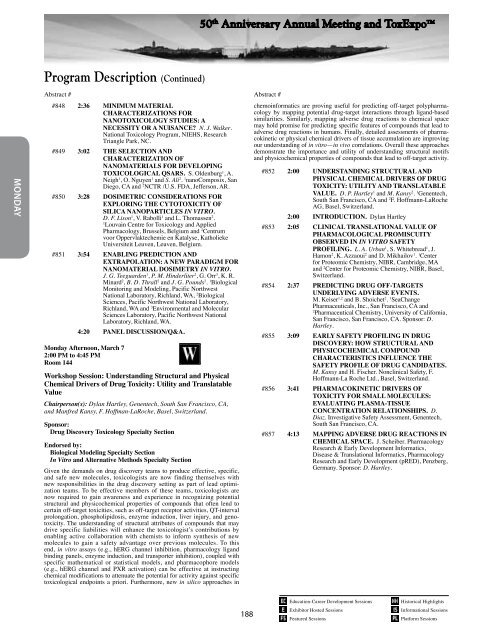Program - Society of Toxicology
Program - Society of Toxicology
Program - Society of Toxicology
You also want an ePaper? Increase the reach of your titles
YUMPU automatically turns print PDFs into web optimized ePapers that Google loves.
50 th Anniversary Annual Meeting and ToxExpo<br />
<strong>Program</strong> Description (Continued)<br />
MONday<br />
Abstract # Abstract #<br />
#848 2:36 MINIMUM MATERIAL<br />
CHARACTERIZATIONS FOR<br />
NANOTOXICOLOGY STUDIES: A<br />
NECESSITY OR A NUISANCE? N. J. Walker.<br />
National <strong>Toxicology</strong> <strong>Program</strong>, NIEHS, Research<br />
Triangle Park, NC.<br />
#849 3:02 THE SELECTION AND<br />
CHARACTERIZATION OF<br />
NANOMATERIALS FOR DEVELOPING<br />
TOXICOLOGICAL QSARS. S. Oldenburg 1 , A.<br />
Neigh 1 , O. Nguyen 1 and S. Ali 2 . 1 nanoComposix, San<br />
Diego, CA and 2 NCTR /U.S. FDA, Jefferson, AR.<br />
#850 3:28 DOSIMETRIC CONSIDERATIONS FOR<br />
EXPLORING THE CYTOTOXICITY OF<br />
SILICA NANOPARTICLES IN VITRO. <br />
D. F. Lison 1 , V. Rabolli 1 and L. Thomassen 2 .<br />
1<br />
Louvain Centre for <strong>Toxicology</strong> and Applied<br />
Pharmacology, Brussels, Belgium and 2 Centrum<br />
voor Oppervlaktechemie en Katalyse, Katholieke<br />
Universiteit Leuven, Leuven, Belgium.<br />
#851 3:54 ENABLING PREDICTION AND<br />
EXTRAPOLATION: A NEW PARADIGM FOR<br />
NANOMATERIAL DOSIMETRY IN VITRO. <br />
J. G. Teeguarden 1 , P. M. Hinderliter 2 , G. Orr 3 , K. R.<br />
Minard 2 , B. D. Thrall 2 and J. G. Pounds 2 . 1 Biological<br />
Monitoring and Modeling, Pacific Northwest<br />
National Laboratory, Richland, WA, 2 Biological<br />
Sciences, Pacific Northwest National Laboratory,<br />
Richland, WA and 3 Environmental and Molecular<br />
Sciences Laboratory, Pacific Northwest National<br />
Laboratory, Richland, WA.<br />
4:20 PANEL DISCUSSION/Q&A.<br />
Monday Afternoon, March 7<br />
2:00 PM to 4:45 PM<br />
Room 144<br />
Workshop Session: Understanding Structural and Physical<br />
Chemical Drivers <strong>of</strong> Drug Toxicity: Utility and Translatable<br />
Value<br />
Chairperson(s): Dylan Hartley, Genentech, South San Francisco, CA,<br />
and Manfred Kansy, F. H<strong>of</strong>fman-LaRoche, Basel, Switzerland.<br />
Sponsor:<br />
Drug Discovery <strong>Toxicology</strong> Specialty Section<br />
Endorsed by:<br />
Biological Modeling Specialty Section<br />
In Vitro and Alternative Methods Specialty Section<br />
Given the demands on drug discovery teams to produce effective, specific,<br />
and safe new molecules, toxicologists are now finding themselves with<br />
new responsibilities in the drug discovery setting as part <strong>of</strong> lead optimization<br />
teams. To be effective members <strong>of</strong> these teams, toxicologists are<br />
now required to gain awareness and experience in recognizing potential<br />
structural and physicochemical properties <strong>of</strong> compounds that <strong>of</strong>ten lend to<br />
certain <strong>of</strong>f-target toxicities, such as <strong>of</strong>f-target receptor activities, QT-interval<br />
prolongation, phospholipidosis, enzyme induction, liver injury, and genotoxicity.<br />
The understanding <strong>of</strong> structural attributes <strong>of</strong> compounds that may<br />
drive specific liabilities will enhance the toxicologist’s contributions by<br />
enabling active collaboration with chemists to inform synthesis <strong>of</strong> new<br />
molecules to gain a safety advantage over previous molecules. To this<br />
end, in vitro assays (e.g., hERG channel inhibition, pharmacology ligand<br />
binding panels, enzyme induction, and transporter inhibition), coupled with<br />
specific mathematical or statistical models, and pharmacophore models<br />
(e.g., hERG channel and PXR activation) can be effective at instructing<br />
chemical modifications to attenuate the potential for activity against specific<br />
toxicological endpoints a priori. Furthermore, new in silico approaches in<br />
chemoinformatics are proving useful for predicting <strong>of</strong>f-target polypharmacology<br />
by mapping potential drug-target interactions through ligand-based<br />
similarities. Similarly, mapping adverse drug reactions to chemical space<br />
may hold promise for predicting specific features <strong>of</strong> compounds that lead to<br />
adverse drug reactions in humans. Finally, detailed assessments <strong>of</strong> pharmacokinetic<br />
or physical chemical drivers <strong>of</strong> tissue accumulation are improving<br />
our understanding <strong>of</strong> in vitro—in vivo correlations. Overall these approaches<br />
demonstrate the importance and utility <strong>of</strong> understanding structural motifs<br />
and physicochemical properties <strong>of</strong> compounds that lead to <strong>of</strong>f-target activity.<br />
#852 2:00 UNDERSTANDING STRUCTURAL AND<br />
PHYSICAL CHEMICAL DRIVERS OF DRUG<br />
TOXICITY: UTILITY AND TRANSLATABLE<br />
VALUE. D. P. Hartley 1 and M. Kansy 2 . 1 Genentech,<br />
South San Francisco, CA and 2 F. H<strong>of</strong>fmann-LaRoche<br />
AG, Basel, Switzerland.<br />
2:00 INTRODUCTION. Dylan Hartley<br />
#853 2:05 CLINICAL TRANSLATIONAL VALUE OF<br />
PHARMACOLOGICAL PROMISCUITY<br />
OBSERVED IN IN VITRO SAFETY<br />
PROFILING. L. A. Urban 1 , S. Whitebread 1 , J.<br />
Hamon 2 , K. Azzaoui 2 and D. Mikhailov 1 . 1 Center<br />
for Proteomic Chemistry, NIBR, Cambridge, MA<br />
and 2 Center for Proteomic Chemistry, NIBR, Basel,<br />
Switzerland.<br />
#854 2:37 PREDICTING DRUG OFF-TARGETS<br />
UNDERLYING ADVERSE EVENTS. <br />
M. Keiser 1,2 and B. Shoichet 2 . 1 SeaChange<br />
Pharmaceuticals, Inc., San Francisco, CA and<br />
2<br />
Pharmaceutical Chemistry, University <strong>of</strong> California,<br />
San Francisco, San Francisco, CA. Sponsor: D.<br />
Hartley.<br />
#855 3:09 EARLY SAFETY PROFILING IN DRUG<br />
DISCOVERY: HOW STRUCTURAL AND<br />
PHYSICOCHEMICAL COMPOUND<br />
CHARACTERISTICS INFLUENCE THE<br />
SAFETY PROFILE OF DRUG CANDIDATES. <br />
M. Kansy and H. Fischer. Nonclinical Safety, F.<br />
H<strong>of</strong>fmann-La Roche Ltd., Basel, Switzerland.<br />
#856 3:41 PHARMACOKINETIC DRIVERS OF<br />
TOXICITY FOR SMALL MOLECULES:<br />
EVALUATING PLASMA-TISSUE<br />
CONCENTRATION RELATIONSHIPS. D.<br />
Diaz. Investigative Safety Assessment, Genentech,<br />
South San Francisco, CA.<br />
#857 4:13 MAPPING ADVERSE DRUG REACTIONS IN<br />
CHEMICAL SPACE. J. Scheiber. Pharmacology<br />
Research & Early Development Informatics,<br />
Disease & Translational Informatics, Pharmacology<br />
Research and Early Development (pRED), Penzberg,<br />
Germany. Sponsor: D. Hartley.<br />
188<br />
Education-Career Development Sessions<br />
Exhibitor Hosted Sessions<br />
Featured Sessions<br />
Historical Highlights<br />
Informational Sessions<br />
Platform Sessions
















